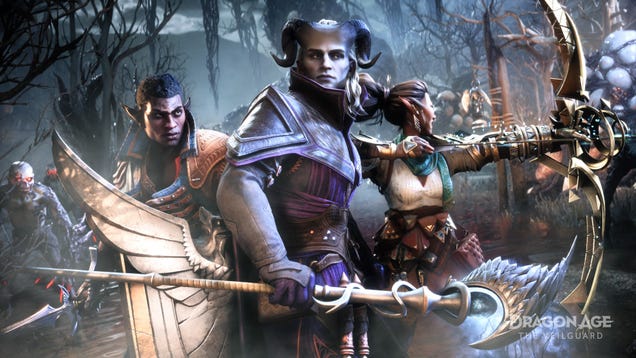It’s been a while since I’ve felt so captivated by such a minimalist game as Arco. A simple but effective revenge tale set against the backdrop of early colonial Mesoamerica, it presents its snappy combat and distinctive worldbuilding with an art style that almost looks like something out of the 8-bit era. Yet the sweeping landscapes are never lacking for detail. And the tale woven across them had me hooked from the start.
Nearly all media about the American frontier focuses on the settler experience, so it’s refreshing to see that Arco presents a rich, thriving, and diverse Native world as the player’s point-of-view, with European “Newcomers” representing a looming, somewhat enigmatic threat. Everything is slightly fantastical, with groups and nations that take inspiration from Mesoamerican and South American indigenous groups, but not too directly modeled after any one real-world society.
And the tapestry they form is treated with the same nuance and depth as the myriad pseudo historical fantasy settings we’re used to based on other parts of the world. The hero of the first two chapters, Tizo, is from the Iyo tribe, who are nomadic nature-worshippers traversing green valleys that reminded me of Central California. The Onem are a monastic community with great monasteries built onto the side of a mountain, reminiscent of Andean societies. The mighty Kanek live in massive temple cities in the jungle, reflecting elements of Aztec, Maya, and Toltec cultures. These groups, collectively, are not treated as culturally monolithic, politically unified, or as one-note stereotypes, and fit together in fascinating ways.
Vendetta
In keeping with the tradition of Western storytelling, however, Arco is ultimately a tale of revenge. Tizo was kidnapped as a child by Newcomers and grew up on a Spanish mission. The first chapter is a brief episode from his early life, when the Newcomers were mostly a subject of rumor and superstition. The second picks up with him as an old man wandering the land, seeking justice for wrongs done to him and his people. It’s fascinating to see how the setting evolves in this time as well, with many of the Native groups adopting more European-influenced ways of life, including one settlement even having their own windmill.
Rather than a cattleman’s revolver, Tizo uses a traditional native bow, the titular “arco”, with which he can quite capably best even gun-toting opponents. Arco’s combat system is a turn-based hybrid, in which you plan out an action while paused, then watch it play out in real time over the course of a few seconds. Movement and positioning are key to success, and there’s also an engaging action economy, where attacks and special abilities generally cost “magia”, which can be refilled a little at a time by moving or much faster by standing still to take a breather.
Let’s Dance
Tizo has to tangle with a troupe of fantastical wildlife inspired by the region, like giant insects and monitor lizards, as well as sometimes bandits and soldiers. He’s joined at various points by allies like the mercenary Zoka and the Kanek prince Kaax, who add an additional element of tactical depth. They each have their own skill trees, too. While Zoka and Kaax specialize in one type of fighting each, Tizo’s skill tree is fairly expansive, and you can choose to focus him more on ranged, melee, or movement-based abilities.
Tizo is also a haunted man, though. Literally. Certain choices you make throughout the story can increase your Guilt, which causes ghosts to spawn during combat who, unlike other enemies, can chase and attack you even when the action is paused and you’re thinking about your next move. This was a little annoying at first. But aside from being a very literal manifestation of how Tizo can’t escape from the regrets of his past, it also trained me to play Arco in a more free-flowing, fast-paced style, which ended up being more fun than agonizing over every move for a long time. It has a nice rhythm to it when you treat it more like an action game.
Fantastical Frontier
In addition to all the different combos and fighting styles that are possible using Tizo’s array of skills, the encounters in Arco never get too stale, either. Many feature enemies with unique mechanics you need to learn, and environmental features that can really turn the tide of battle. I never felt like I was being thrown into samey trash fights just as an excuse to inject some action. From dodging sandworms in the cactus-decked drylands to exploring an ancient, abandoned temple under attack by treasure-hunters, Arco always seems conscious that variety is the spice of life when it comes to environment and encounter design.
I found I was often rewarded for exploring every little corner with hidden loot, memorable side quests like tracking down some poachers, or even a simple fishing minigame. The world isn’t only richly imagined. It’s also full of stuff to do.
There are lots of little touches, too. Each individual area is fairly small, but the world altogether is actually quite large. And I found I was often rewarded for exploring every little corner with hidden loot, memorable side quests like tracking down some poachers, or even a simple fishing minigame. The world isn’t only richly imagined. It’s also full of stuff to do.
I look forward to making my way through the remainder of Arco’s stories, which focus on different characters, and learning Tizo’s eventual fate along the way. This is one of those somewhat unassuming indie games that surprised me with the grandeur, imagination, and affection present in its storytelling, offering a totally new perspective on some classic elements of the Western genre. I already think it will be close to the front of my mind when I talk about the hidden gems of 2024. You’ll be able to saddle up and give it a try yourself later this summer.




